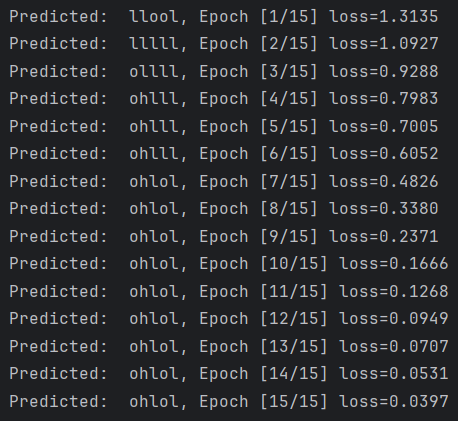Appearance
Basic RNN
RNN:循环神经网络
可以用RNN处理有一定顺序的输入。
What is RNNs?

RNN Cell实际上是一个线性层,可以把一个维度的向量映射成另外一个维度的向量。经常会把RNN的结构画成左图的样子,是因为RNN Cell是共享的,展开后就是右图的样子。x是输入序列,项之间存在顺序关系,所以前一项的输出需要送入后一项的RNN Cell。对于第一个x,如果有先验知识可以将其作为送入第一项的RNN Cell,没有的话送入一个和其它h维度相同的全0向量。
大体过程可以由下述代码表示:
line = Linear()
h = 0
for x in X:
h = line(x,h)由循环实现,所以称之为循环神经网络。
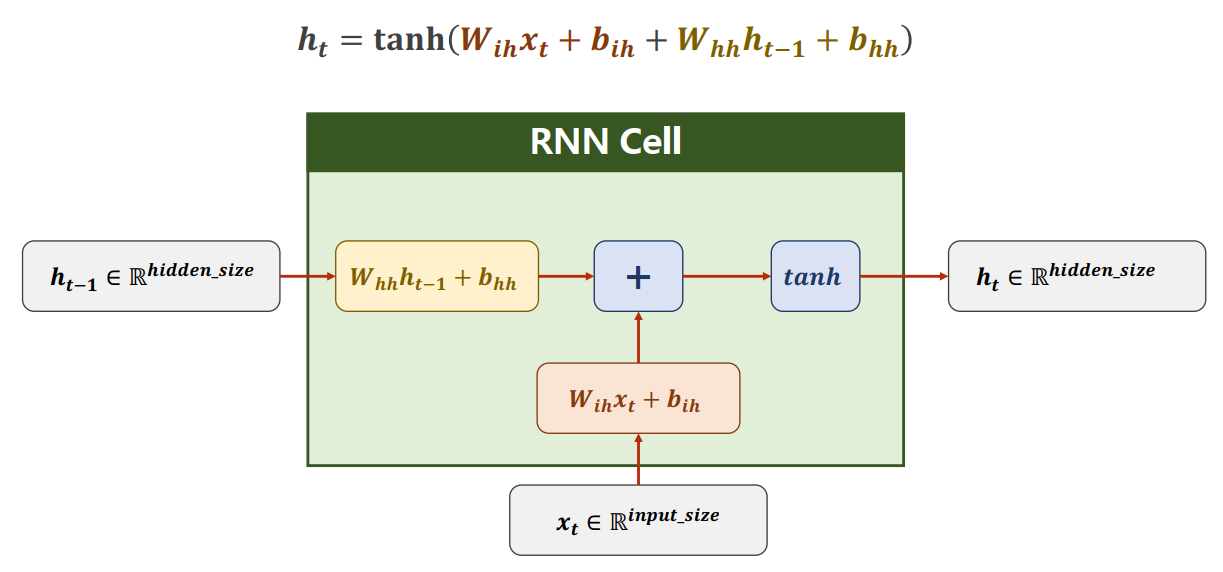
先对输入作一次线性变换,的维度应该是,把输入的维度由变为,然后加上偏置。
对上一项的输出作一次线性变换,的维度应该是,输入的维度维持不变,然后加上偏置。
把上述变换后的结果相加(信息融合),然后做激活。循环神经网络喜欢使用tanh作激活,因为tanh的范围是[-1,1],被认为是效果比较好的。
发现可以进行如下变换:
所以实际实现的过程中,会先把与拼接为的矩阵,然后使用的权重。
看似两个线性层,实际上一个线性层就可以完成。
RNN Cell in PyTorch
How to Use RNNCell
cell = torch.nn.RNNCell(input_size=input_size, hidden_size=hidden_size)
hidden = cell(input, hidden)构造数据时需要满足:
- input的维度为
- hidden的维度为
Suppose we have sequence with below properties:
- batchSize=1(批量)
- seqLen=3(序列长度)
- inputSize=4
- hiddenSize=2
So the shape of inputs and outputs of RNNCell:
- input.shape=(batchSize,inputSize)
- output.shape=(batchSize,hiddenSize)
The sequence can be wrapped in one Tensor with shape:
- dataset.shape=(seqLen,batchSize,inputSize)
import torch
batch_size = 1
seq_len = 3
input_size = 4
hidden_size = 2
cell = torch.nn.RNNCell(input_size=input_size, hidden_size=hidden_size)
# (seq, batch, features)
dataset = torch.randn(seq_len, batch_size, input_size)
hidden = torch.zeros(batch_size, hidden_size)
for idx, input in enumerate(dataset):
print('=' * 20, idx, '=' *20)
print('Input size: ',input.shape)
hidden = cell(input, hidden)
print('outputs size: ', hidden.shape)
print(hidden)How to Use RNN
cell = torch.nn.RNN(input_size=input_size, hidden_size=hidden_size, num_layers=num_layers)
out, hidden = cell(inputs, hidden)Tips
相比于RNNCell,RNN还需要参数num_layers(可以有多层RNN Cell)。
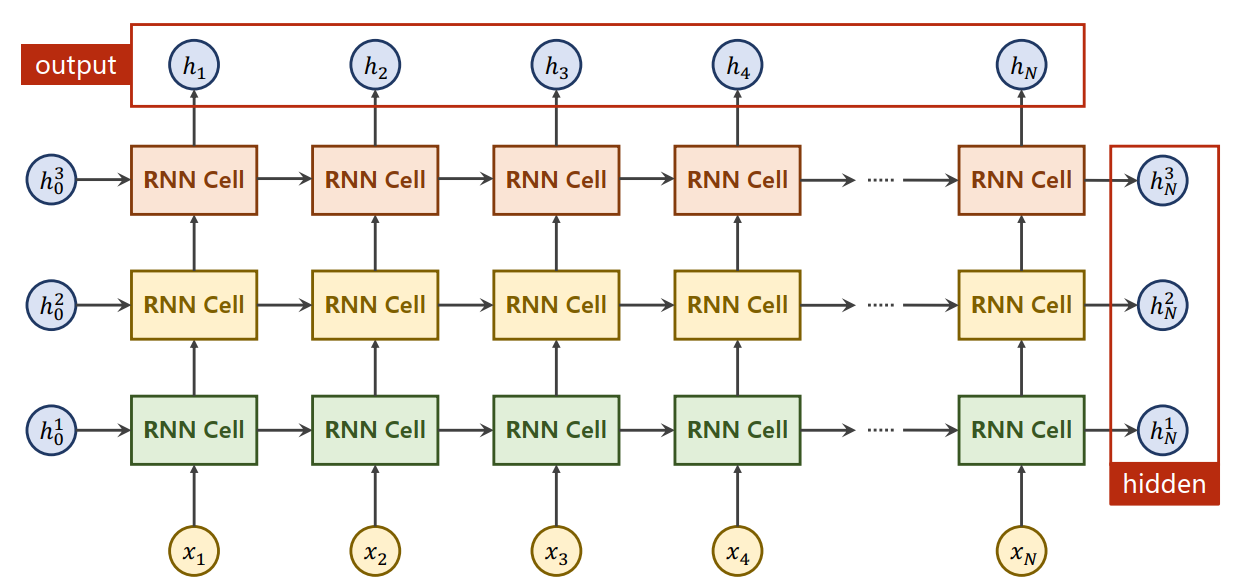
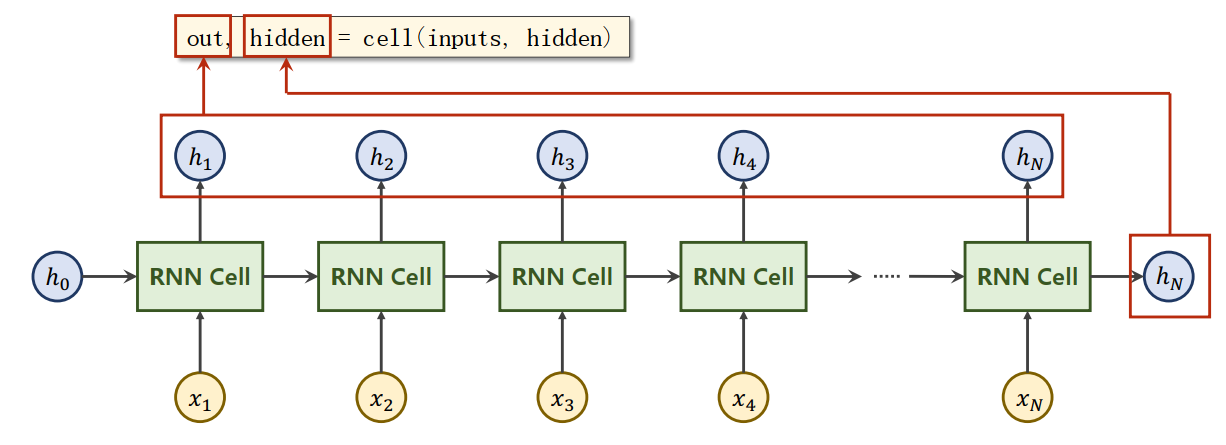
使用RNN不需要自己写循环。使用时需要把所有的input输入,输出的是所有的隐层out,以及最后的。
构造数据时需要满足:
- inputs的维度为
- hidden的维度为
输出:
- out的维度为
- hidden的维度为
Suppose we have sequence with below properties:
- batchSize
- seqLen
- inputSize, hiddenSize
- numLayers
The shape of input and h_0 of RNN:
- input.shape=(seqLen,batchSize,inputSize)
- h_0.shape=(numLayers,batchSize,hiddenSize)
The shape of output and h_n of RNN:
- output.shape=(seqLen,batchSize,hiddenSize)
- h_n.shape=(numLayers,batchSize,hiddenSize)
import torch
batch_size = 1
seq_len = 3
input_size = 4
hidden_size = 2
num_layers = 1
cell = torch.nn.RNN(input_size=input_size, hidden_size=hidden_size, num_layers=num_layers)
# (seqLen, batchSize, inputSize)
inputs = torch.randn(seq_len, batch_size, input_size)
hidden = torch.zeros(num_layers, batch_size, hidden_size)
out, hidden = cell(inputs, hidden)
print('Output size: ', out.shape)
print('Output: ', out)
print('Hidden size: ', hidden.shape)
print('Hidden: ', hidden)Tips
RNN的另一个可用的参数batch_first

Example: Using RNNCell
Train a model to learn: "hello" -> "ohlol"

首先要将字符向量化。
- 构造一个词典,给每个字符分配一个索引
- 根据词典把每个词变成相应的索引,然后转化为向量
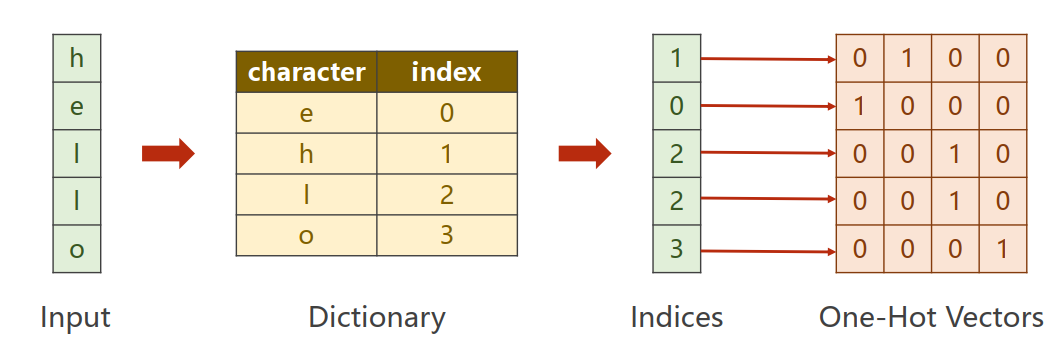
inputSize=4

实际上这是一个分类问题,判断输出应该是哪一个字母,使用向量表示,即输出的是一个长度为4的向量。拿这个长度为4的向量接一个交叉熵就变成一个分布。
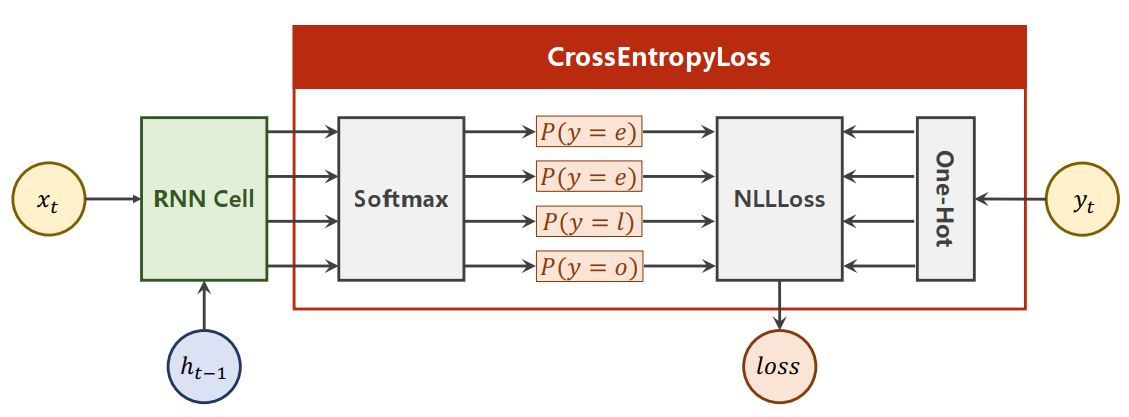
outputSize=4
RNNCell
使用RNNCell完整代码如下:
import torch
input_size = 4
hidden_size = 4
batch_size = 1
# Prepare Data
idx2char = ['e', 'h', 'l', 'o']
x_data = [1, 0, 2, 2, 3]
y_data = [3, 1, 2, 3, 2]
one_hot_lookup = [[1, 0, 0, 0],
[0, 1, 0, 0],
[0, 0, 1, 0],
[0, 0, 0, 1]]
x_one_hot = [one_hot_lookup[x] for x in x_data]
inputs = torch.Tensor(x_one_hot).view(-1, batch_size, input_size)
labels = torch.LongTensor(y_data).view(-1, 1)
# Design Model
class Model(torch.nn.Module):
def __init__(self, input_size, hidden_size, batch_size):
super().__init__()
self.batch_size = batch_size
self.input_size = input_size
self.hidden_size = hidden_size
self.rnncell = torch.nn.RNNCell(input_size=self.input_size, hidden_size=self.hidden_size)
def forward(self, input, hidden):
hidden = self.rnncell(input, hidden)
return hidden
# 生成默认的h0
def init_hidden(self):
return torch.zeros(self.batch_size, self.hidden_size)
net = Model(input_size, hidden_size, batch_size)
# Loss and Optimizer
criterion = torch.nn.CrossEntropyLoss()
optimizer = torch.optim.Adam(net.parameters(), lr=0.1)
# Training Cycle
for epoch in range(15):
loss = 0
optimizer.zero_grad()
hidden = net.init_hidden()
print('Predicted string: ', end='')
for input,label in zip(inputs, labels):
hidden = net(input, hidden)
loss += criterion(hidden, label)
_, idx = hidden.max(dim=1)
print(idx2char[idx.item()],end='')
loss.backward()
optimizer.step()
print(', Epoch [%d/15] loss=%.4f' % (epoch+1, loss.item()))运行结果:
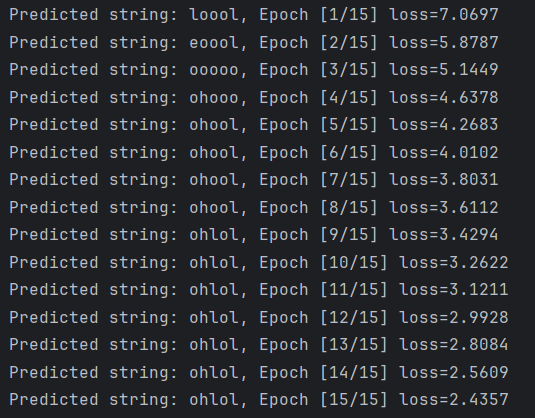
RNN
使用RNN,需要修改数据、模型、训练周期:
import torch
input_size = 4
hidden_size = 4
num_layers = 1
batch_size = 1
seq_len = 5
# Prepare Data
idx2char = ['e', 'h', 'l', 'o']
x_data = [1, 0, 2, 2, 3]
y_data = [3, 1, 2, 3, 2]
one_hot_lookup = [[1, 0, 0, 0],
[0, 1, 0, 0],
[0, 0, 1, 0],
[0, 0, 0, 1]]
x_one_hot = [one_hot_lookup[x] for x in x_data]
inputs = torch.Tensor(x_one_hot).view(seq_len, batch_size, input_size)
labels = torch.LongTensor(y_data)
# Design Model
class Model(torch.nn.Module):
def __init__(self, input_size, hidden_size, batch_size, num_layers=1):
super().__init__()
self.num_layers = num_layers
self.batch_size = batch_size
self.input_size = input_size
self.hidden_size = hidden_size
self.rnn = torch.nn.RNN(input_size=self.input_size, hidden_size=self.hidden_size, num_layers=num_layers)
def forward(self, input):
hidden = torch.zeros(self.num_layers, self.batch_size, self.hidden_size)
out, _ = self.rnn(input, hidden)
return out.view(-1, self.hidden_size)
net = Model(input_size, hidden_size, batch_size, num_layers)
# Loss and Optimizer
criterion = torch.nn.CrossEntropyLoss()
optimizer = torch.optim.Adam(net.parameters(), lr=0.1)
# Training Cycle
for epoch in range(15):
optimizer.zero_grad()
outputs = net(inputs)
loss = criterion(outputs, labels)
loss.backward()
optimizer.step()
_, idx = outputs.max(dim=1)
idx = idx.data.numpy()
print('Predicted: ', ''.join([idx2char[x] for x in idx]), end='')
print(', Epoch [%d/15] loss=%.4f' % (epoch+1, loss.item()))运行结果:
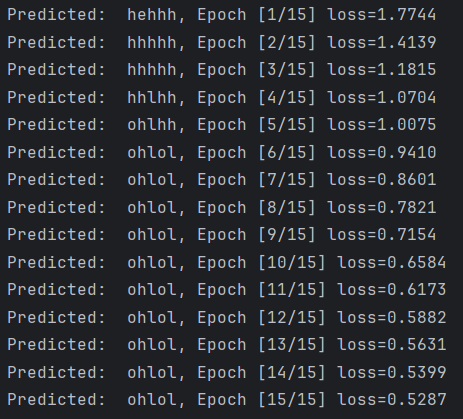
Associate a vector with a word/character
使用独热向量处理字符的缺点:
- 维度太高(维度诅咒)
- 稀疏
- 硬编码
一种常见且强大的方式:EMBEDDING(嵌入层)
EMBEDDING将高维的稀疏的样本映射到低维的稠密的空间中(数据降维):
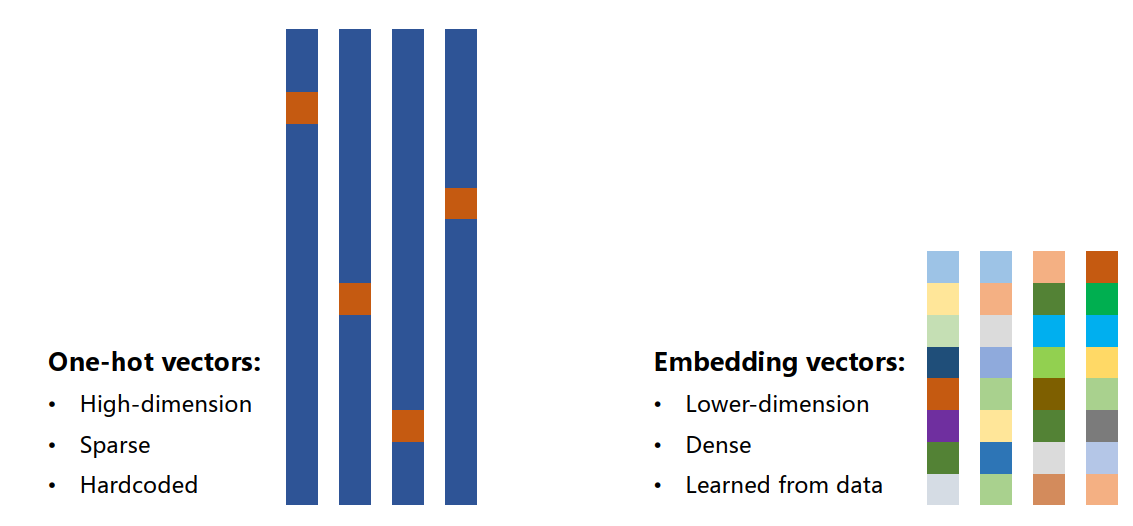
EMBEDDING是如何操作的:
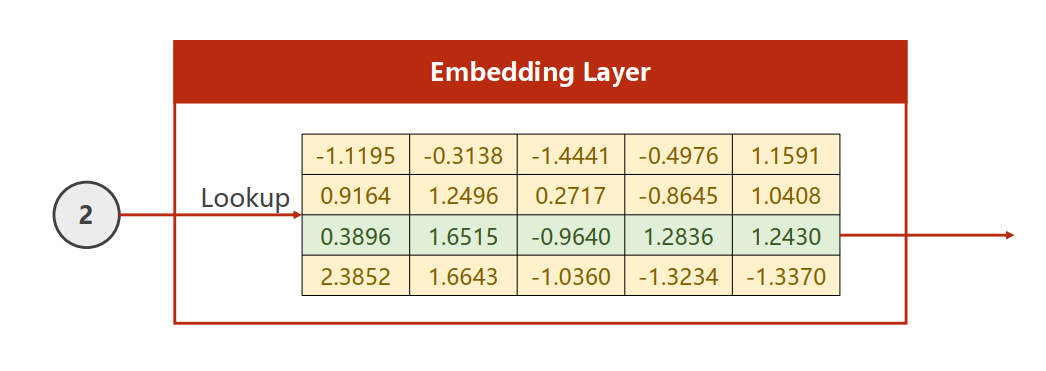
EMBEDDING Layer通过让权重矩阵与独热向量相乘可以将input_size的向量转化为embedding_size的向量。
Using Embedding and Linear Layer
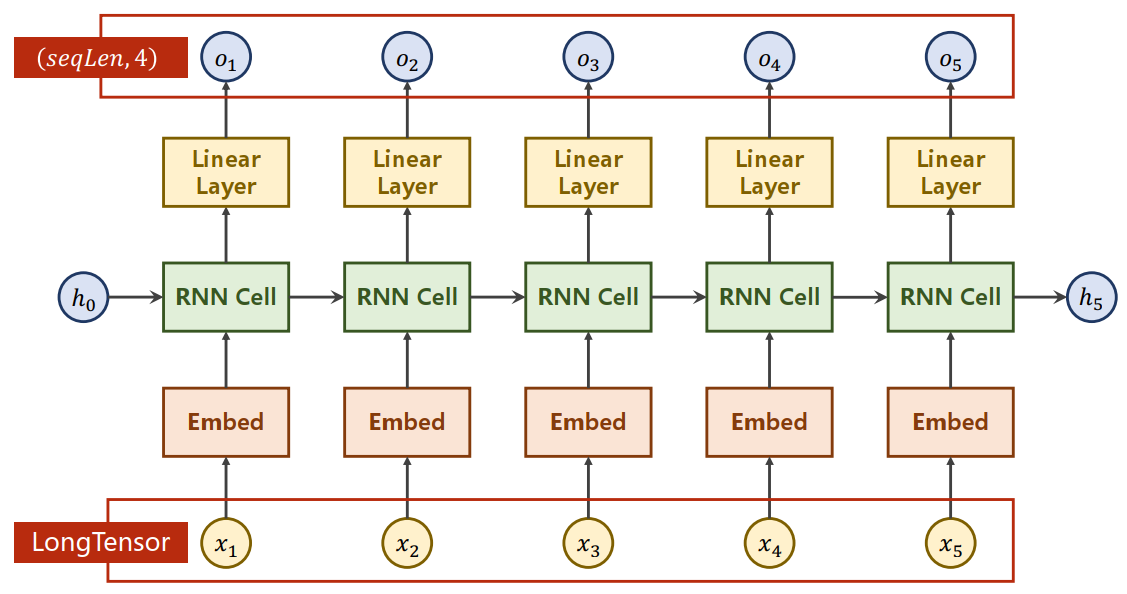
import torch
num_class = 4
input_size = 4
hidden_size = 8
embedding_size = 10
num_layers = 2
batch_size = 1
seq_len = 5
# Prepare Data
idx2char = ['e', 'h', 'l', 'o']
x_data = [[1, 0, 2, 2, 3]]
y_data = [3, 1, 2, 3, 2]
inputs = torch.LongTensor(x_data)
labels = torch.LongTensor(y_data)
# Design Model
class Model(torch.nn.Module):
def __init__(self):
super().__init__()
self.emb = torch.nn.Embedding(input_size, embedding_size)
self.rnn = torch.nn.RNN(input_size=embedding_size,
hidden_size=hidden_size,
num_layers=num_layers,
batch_first=True)
self.fc = torch.nn.Linear(hidden_size, num_class)
def forward(self, x):
hidden = torch.zeros(num_layers, x.size(0), hidden_size)
x = self.emb(x)
x, _ = self.rnn(x, hidden)
x = self.fc(x)
return x.view(-1, num_class)
net = Model()
# Loss and Optimizer
criterion = torch.nn.CrossEntropyLoss()
optimizer = torch.optim.Adam(net.parameters(), lr=0.05)
# Training Cycle
for epoch in range(15):
optimizer.zero_grad()
outputs = net(inputs)
loss = criterion(outputs, labels)
loss.backward()
optimizer.step()
_, idx = outputs.max(dim=1)
idx = idx.data.numpy()
print('Predicted: ', ''.join([idx2char[x] for x in idx]), end='')
print(', Epoch [%d/15] loss=%.4f' % (epoch + 1, loss.item()))运行结果:
